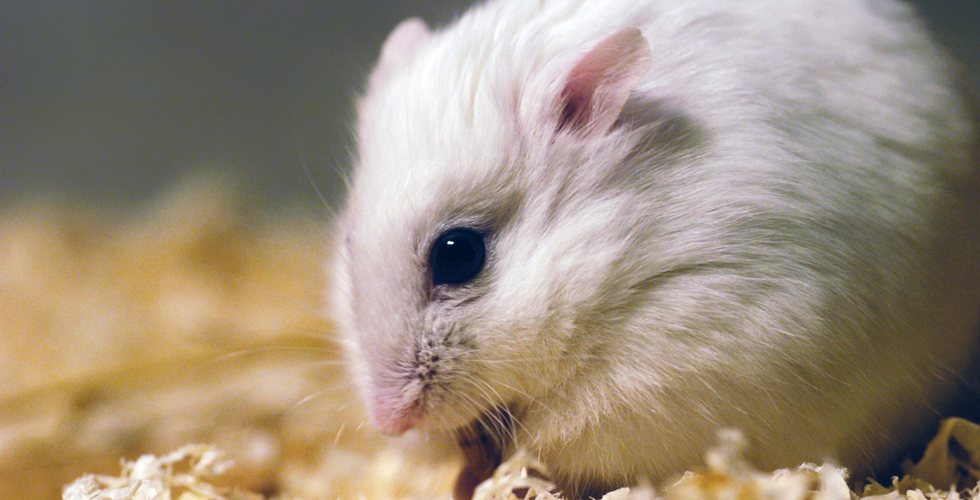Shorter Days Flip Genetic Switch To Halt Hamster Mating

Winter white Russian dwarf hamster.
Simon Eugster via Wikimedia Commons | bit.ly/1gere0w
bit.ly/c6nCoV
(ISNS) -- As winter chills settle in, we turn our clocks back and our heaters up. Other animals have their own ways of adapting – some grow winter coats, and some hibernate.
Siberian hamsters don't hibernate or change color; instead, they use winter as a sort of seasonal birth control. Not mating when the temperature drops ensures that hamster babies are not born in harsh weather.
Researchers have now found one part of the genetic switch that keeps these hamsters in tune with the times. A chemical marker in the animals' brains switches off a gene that controls breeding, as days grow shorter in the winter.
Months later, the genetic snooze button releases, turning reproductive abilities back on in time for spring. The switch in question is literally a fragment of a molecule that sits on a gene. It's what scientists call an "epigenetic control" – it turns the gene on and off in response to external stimuli, such as short winter days.
Tyler Stevenson, from the University of Aberdeen in Scotland, and Brian Prendergast, from the University of Chicago, reported these results last month in the Proceedings of the National Academy of Sciences.
Both plants and animals use epigenetic controls to change how genes respond to the outside world. One of these controls is perhaps the most familiar hallmarks of the changing seasons – spring flowering. In humans, similar controls synchronize thousands of genes to our daily habits, turning genes off and on at specific times of the day.
"Animals use epigenetic mechanisms to regulate daily biological rhythms, but this is the first example of a seasonal response in animals that is controlled by a reversible epigenetic mechanism," said Stevenson, a behavioral neuroscientist, and the study's lead author.
Researchers studying Siberian hamsters have long known that these rodents don't breed in the winter. But the molecular switches that turn reproduction off and on in response to seasonal day lengths were not as obvious.
The hamsters' brains read seasons in the language of melatonin levels. Short, wintry days increase melatonin production; long bright days decrease its production, signaling the onset of spring – and breeding season.
In their study, Stevenson and Prendergast found that winter-like short days increased the brain expression of a gene that controls the size of the hamsters' testes. Epigenetic activation of this gene, called dio3, caused a decrease in hamsters' gonad size in the winter months. After approximately five months, the epigenetic switch reduced dio3 expression. With dio3 reduced, the hamsters regained their reproductive abilities in time for warmer weather.
"The decrease in dio3 expression we observed is one of the earliest steps identified in switching reproductive function from its dormant winter state to an active ‘summer mode,'" said Stevenson.
"The results are an attempt to address a very long-standing question in the field of biological rhythms," said Eric Mintz, a researcher at Kent State University, in Ohio, who studies circadian and behavioral rhythms in rodents.
"Some seasonally breeding animals, like these hamsters, shut down their reproductive systems as winter approaches, presumably to avoid wasting energy. After a certain amount of time, their systems recover and become active again," explained Mintz. "This paper addresses one part of the mechanism which causes that recovery."
"With this work we were looking at a particular gene – but it is likely that this mechanism is functioning on a much larger scale," said Stevenson.
Seasonal breeding, like most behaviors, is a complex process controlled by hundreds of genes. The expression of dio3 is only one piece of the puzzle in hamsters, but the on-off epigenetic switch that Stevenson and Prendergast have identified could control many other hamster genes. And similar mechanisms might even be at play in other animals.
From spring-breeding songbirds and hibernating bears to signs of spring fever in humans, the seasons change us all. Whether the underlying genetic changes are similarly controlled, only time – and more research – will tell.
Jyoti Madhusoodanan is a science writer based in San Jose, Calif. She tweets at @smjyoti.
Correction: the original version of this story stated that Tyler Stevenson was affiliated with the University of Chicago. He works at the University of Aberdeen in Scotland. We regret the error.
